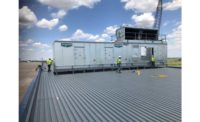Ask most professionals in the HVAC industry what their biggest concern is and almost all will say it is the lack of skilled workers entering the field. This labor shortage has been on everyone’s radar for a long time, but solutions have remained somewhat elusive. Joe Nichter, president, Comfort Systems USA, Southwest, Chandler, Ariz., has addressed the issue head-on by changing the way his company designs and builds mechanical systems.
“We were looking for a way to improve productivity in order to overcome the skilled trade shortage, so we turned to prefabrication and modular solutions, which helped alleviate the problem,” said Nichter. “We are now building complete modular restrooms, head walls, and racking systems for all the mechanical trades in our shop. This process has reduced the number of people needed on-site and improved the overall construction schedule. In addition, we have found that this new approach equates to quality, productivity, and safety in the work environment for our employees.”
Higher Quality, Less Labor
The modular concept is not really new at Comfort Systems USA, Southwest, as seven years ago the company invented the HydroKool modular chiller plant, which was sold to McQuay (now Daikin Applied) in June 2010. In addition, the company has been fabricating plumbing chase walls in its cavernous facility for five or six years. These racks are fully assembled and tested in the facility before they are taken to the job site, where they can be quickly and easily installed. Applying that concept to HVAC racks, however, took a lot more research and development.
Nichter estimates that the company spent 400-500 man-hours figuring out how to design and build the first prefabricated HVAC rack. “We met with some people from Europe, where prefabrication is more widely used, and they helped us answer all the questions, such as what materials should we use to construct the rack? How are we going to ship it? Can we use a crane to install it?
“In the end, we found that what we needed to do first was to change our thought process — we had to stop thinking of ourselves as a sheet metal shop and instead consider ourselves to be a manufacturer.”
To that end, all trades — electrical, plumbing, and mechanical — were brought in-house, where, for the last year, they have worked cooperatively to build 20-foot-long HVAC racks, each of which contains the piping, ductwork, cabling, etc. required for the commercial/industrial application under construction. Once the prefabricated sections are completed and tested, they are wrapped up, placed on a truck, and hauled to the job site, where they are pieced together after a crane hoists them into place, then tied into the building’s central plant (which is often modular, as well).
Fabricating the racks in-house has not only resulted in better quality control, it has been a huge time saver, noted Nichter. “It takes eight people about 26 hours to construct four HVAC racks in-house, which are then connected on-site to form 80-foot sections. When compared to traditional field installations, this method has reduced overall fabrication and installation time by 30 percent and contributed to a material savings of 5 percent.”
Another benefit to prefabricating the HVAC racks is that it provides the perfect training ground for new employees in a clean work environment. “In this industry, we can’t train people fast enough to take the place of retiring workers,” said Nichter. “Building the racks in-house allows us to supervise manymore people than we could in the field. This way, we can train them here and make sure they are up to speed before they go out in the field.”
So far, the prefabricated HVAC racks have been well received by customers and general contractors who appreciate the fact that this new process has resulted in reduced costs, time savings, and better quality control. The racks have been installed in several prisons, hospitals, and warehouses, and Nichter believes this trend will continue to grow. “By incorporating a manufacturing component into each job, we have reduced the need for field labor, improved the construction schedule, reduced accidents, and increased our profit margins. It’s been very successful for us.”
Modular Solutions
Manufacturers are also seeing the benefits of offering prefabricated solutions, as evidenced by the growing popularity of modular central plants (MCPs). These plants are assembled (all or in part) and tested at the factory and include all the components needed to make and distribute chilled and/or hot water in just about any commercial or industrial setting, including schools, data centers, medical centers, and hotels. MCPs offer numerous benefits, including the fact that they do not require as much skilled labor as site-built plants.
This is an important consideration, noted Barry Naegele, director of modular central plant solutions sales, Daikin Applied, as the skilled labor force of welders, pipe fitters, plumbers, and electricians is aging, with nearly one in five construction workers expected to retire in the next few years. “Quality and speed of deployment are also driving a trend toward modular solutions, the same way that occurred when the industry went away from built-up air conditioning systems to packaged chillers and rooftop systems. This is just the next evolution in that trend.”
Besides the lack of skilled tradespeople, MCPs are also becoming more popular because engineers are being pressed to provide quicker drawings at a lower cost, and owners are tired of change orders, said Terry Moses, CEO, Systecon Inc. “Look at every other industry and you will see that modular construction results in a better, faster, and less expensive product.”
MCPs are often stand-alone structures (housed inside or outside a building) that are constructed of steel I-beams and wall posts, which are then enclosed with insulated wall panels and some type of doors for access, explained Naegele. The primary equipment in an MCP includes chillers, boilers, pumps, cooling towers, VFDs (variable-frequency drives), exhaust fans, electrical panel boards, and control panels, as well as piping, electrical wiring and conduit, water treatment systems, expansion tanks, air conditioning for the interior of the space, lighting, makeup water lines, drain lines, vent lines, etc.
“In addition to these features, certain manufacturers will offer options such as refrigerant monitoring systems, basin filtration, air and dirt separators, chemical-free water treatment, single point power connections, glycol feed systems, etc.,” he said.
Once constructed, MCPs are tested in the factory, although the amount of testing may vary from one manufacturer to the next, said Moses. “The amount of testing needs to be specified. It can be as simple as a hydro test and wiring check out, but it is better to completely run the pumps and chillers to verify their operation. A complete control sequence along with failure routines should also be performed, as should a performance test to verify the energy performance of the total plant at various loads.”
Design, Installation, and Maintenance
As can be imagined, the design process of MCPs differs somewhat from site-built plants. With site-built applications, said Naegele, engineers often design occupied mechanical equipment rooms to not only meet the requirements for heating and cooling, but to support other needs such as offices, storage, and shop work space. “With an MCP, engineers work with the manufacturer to select equipment that meets the heating and cooling requirements of that specific project and its constraints, but doesn’t necessarily support any of those other functions. Engineers need to really understand the main project drivers first, and if these lead to an MCP as the solution, they should not try to design it like an occupied mechanical equipment room.”
Once engineers decide that an MCP is the solution, they typically specify the types of systems required, outdoor design conditions, capacity, and energy performance, as well as the space available, location of the piping to the building, and electrical services, said Moses. Then, the modular plant manufacturer provides a preliminary layout showing all the components, along with safety and maintenance clearances. “Manufacturers know how to arrange the components so they can ship over the road and be reassembled easily, as well as all the mundane details of safety and service. The design engineers review this work to make sure it meets their standards.
“Installation varies from one manufacturer to the next, with some offering MCPs that are complete ETL-listed pieces of equipment that have been fully assembled at the factory and only require reassembly in the field, said Naegele. “In this instance, a crane will lift the pieces onto an already prepared concrete housekeeping pad or structural steel base at the site, where the pieces will be reconnected. A small- to medium-sized plant of up to four modules can usually be rigged into place in a single day. Once the main pieces are set into place, the piping and electrical interconnections between modules are reconnected, and the site utilities for electrical, makeup water, chilled water supply and return, hot water supply and return, and sanitary drain are made. Then the system is ready for start-up.”
A good manufacturer should provide complete installation instructions to the contractor well before shipment, said Moses, and these instructions should include 3-D images. “In fact, a major benefit of modular construction is that all equipment is laid out in three-dimensional drawings — every piece of equipment is modeled down to the bolts. Unlike site-built systems, these three-dimensional drawings can be reviewed prior to construction, so things can be moved without cost to the owner, thus eliminating field change orders.”
While maintenance requirements for MCPs are usually the same as a site-built plant, some manufacturers simplify that service by incorporating features, such as trolleys over all pumps, water treatment systems, floor drains at all locations where water needs to be drained off for service, and even removable wall and roof panels for major service events, said Naegele.
There is no question the lack of skilled labor will be an issue in the HVAC industry for years to come, but with the advent and acceptance of modular solutions, contractors and manufacturers alike have seemingly found a way to work around this ongoing problem.
Publication date: 5/5/2014
Want more HVAC industry news and information? Join The NEWS on Facebook, Twitter, and LinkedIn today!














